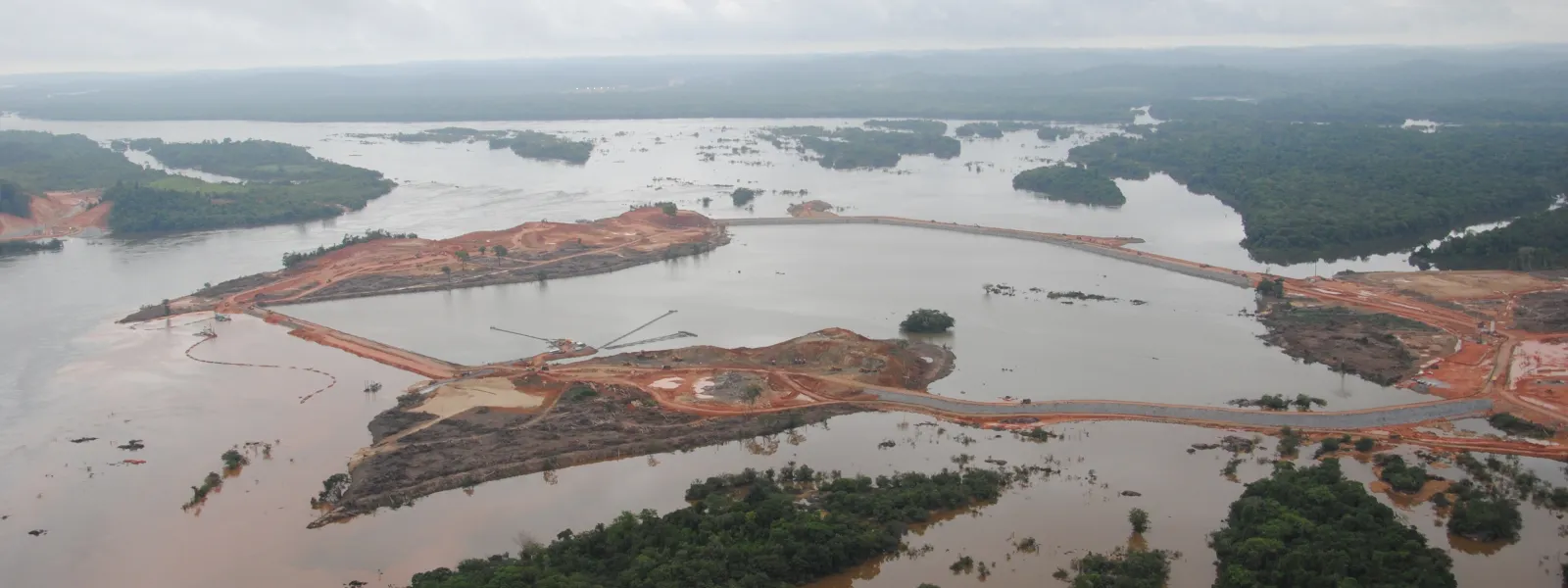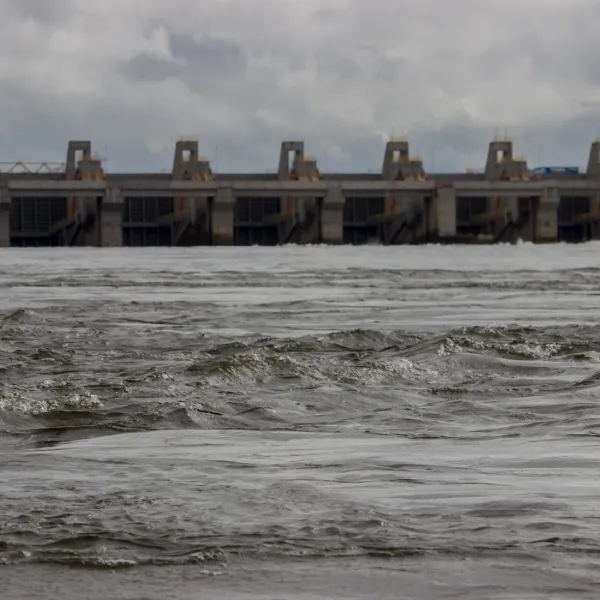
Project
Programa de Aceleração do CrescimentoHalting the implementation of large dams in the Americas
The more we learn, the clearer it becomes that large dams are unsustainable energy sources.
From the Mexican highlands to the Amazon River basin, hydroelectric mega-projects are aggravating climate change, destroying sensitive ecosystems, and threatening human rights and indigenous cultures.
In October 2016, a research study from Washington State University found that the world’s reservoirs generate 1.3 percent of all greenhouse gases (more than the total emissions of Canada!), confirming the damage dams do to our climate.
Large dams have no place on our rapidly changing planet. In a time of intensifying droughts, many vulnerable hydropower-dependent countries are facing energy shortages. And as extreme weather events increase around the world, the inherent danger of large dams becomes more evident.
Throughout the construction of Belo Monte, the world’s third largest dam, we’ve seen firsthand the grave impacts these projects have on the ecosystems in which they’re built. We’ve witnessed the violations they impose on the rights of indigenous and riverine communities, whose culture and livelihoods are tied so closely to the natural world.
Yet, across Latin America and the world, large dams are still being promoted as “clean and green” energy sources; and are even receiving support from national and international climate initiatives.
That support is part of the reason more than 3,700 large dams are currently being planned or constructed worldwide, more than 400 of which have been proposed for the vital Amazon River Basin.
At AIDA, we’re proud to be part of a team leading the fight against large dams across Latin America and beyond.
Partners:

Related projects
Threats from Proposed Dam in La Parota, Mexico, Challenged in Amicus Curiae Legal Brief
AIDA and other international and Mexican organizations submitted a legal brief (Amicus Curiae) to the Collegiate Tribunal of Guerrero in Acapulco in support of a constitutional lawsuit brought by CECOP and the Mexican Center for Environmental Law against the Federal Commission of Electricity (CFE) and other authorities. The lawsuit alleges that the Mexican authorities failed to consult with affected parties and adequately evaluate the environmental impacts of the construction of La Parota dam. Approval of the hydroelectric project disregards national laws, as well as international human rights and environmental laws, including those that protect the rights to a fair trial and economic, social and environmental rights. Among other things, the project’s major human rights violations are a lack of information provided to those affected by the dam and gaps in the comprehensive environmental impact study, which is designed to evaluate damages the dam will cause, measures to prevent impacts, as well as alternatives to the project. Considering these flaws and the human rights violations of people affected by the La Parota megaproject, we appealed to the Collegiate Tribunal of Guerrero, arguing that it should make use of its power, accept the arguments of the Amicus, and cancel all work related to the construction of the La Parota dam until the Mexican government completely complies with local people’s demands and applicable national and international laws. AIDA will continue pursing this paradigmatic case because it is an example of how infrastructure development can cause severe environmental damages and human rights violations in the hemisphere.
Read moreHuman Rights Body Calls on Peru to Protect Citizens from Contamination by American-Owned Smelter
For immediate release: September 5, 2007 PRESS CONTACTS: Astrid Puentes, AIDA (+5255) 52120141 [email protected] Martin Wagner, (510) 550-6700 [email protected] Human Rights Body Calls on Peru to Protect Citizens from Contamination by American-owned Smelter Oakland, CA; Lima, Peru – The Inter-American Commission on Human Rights (IACHR) has asked the government of Peru to take immediate steps to protect the health of inhabitants of La Oroya, Peru, who suffer severe health impacts due to contamination from a smelter owned by American billionaire Ira Rennert. Rennert’s company, Doe Run Peru, owns and operates the smelter. La Oroya residents suffer health problems related to emissions of lead, arsenic, cadmium, sulfur dioxide and other pollution from the smelter. In 2006, the Blacksmith Institute identified La Oroya as one of the ten most polluted places in the world (http://www.blacksmithinstitute.org/ten.php). The Commission ordered Peru to conduct comprehensive medical examinations to determine the extent of the injury to local people and to provide medical treatment to those who need it. The Commission acted in response to a petition submitted by lawyers from the Peruvian Society for Environmental Law (SPDA), the Inter-American Association for Environmental Defense (AIDA), Earthjustice, and the Center for Human Rights and Environment. The petition was filed on behalf of a group of La Oroya residents claiming that Peru’s failure to control the smelter pollution violates their human rights, and especially those of the most vulnerable population – the children impacted by the severe lead contamination. “Controlling contamination from the smelter is crucial to protect the rights and lives of these people,” said Astrid Puentes of AIDA. “The Commission’s action confirms that neither Peru nor the company have taken adequate steps to protect health and human rights in La Oroya,” she added. Since 1999, the Government of Peru has known that almost all the children living near the complex suffer from lead poisoning, yet has failed to remedy the situation. A March 2005 study showed that 99 percent of the children tested had blood lead levels vastly exceeding the safe limits established by the US EPA and the World Health Organization. “We are celebrating, with the hope that we will finally have positive results for the protection of the health of our children, and ourselves,” said one La Oroya petitioner, who, like all the petitioners, has asked to remain anonymous for fear of retaliation by company workers. “In calling on Peru to protective the people of La Oroya, the Commission is indicating its support for people throughout the hemisphere who are threatened by extreme toxic contamination,” said Earthjustice’s Martin Wagner. “The Commission is acknowledging that this kind of pollution violates human rights, and that international law thus requires governments to prevent such tragedies and to take steps to remedy them when they happen. The Commission’s request is based on its interpretation of Peru’s international legal obligations, and it is the government’s responsibility to satisfy those obligations.” “We hope to see the transparent, effective, and rapid implementation of these precautionary measures by Peruvian government authorities” declared Carlos Chirinos, from the SPDA. “The government has moved far too slow in addressing this health crisis,” he added. The Commission’s decision is a preliminary step in its consideration of the petition from the residents of La Oroya. “The Commission has clearly decided that the people in La Oroya cannot afford to await the outcome of the full petition process,” said Wagner. “No matter what the details of its final decision, the Commission is obviously convinced that rights are being violated and the government must act now.”
Read moreFederal Judge Suspends Construction of the La Parota Hydroelectric Project!
FOR IMMEDIATE RELEASE August 28, 2007 CONTACT: Claudia Gómez-Portugal, (5255) 5268-3323 ext. 23, [email protected] Federal Judge Suspends Construction of the La Parota Hydroelectric Project! Mexico DF. August 28, 2007 - On August 14th, a federal judge in Acapulco, in the state of Guerrero, ordered the temporary suspension of all work related to the La Parota Hydroelectric Project, in response to an accion de amparo (similar to an injunction) filed by small-scale farmers in the Community of Common Goods of Cacahuatepec. The farmers are represented by the Mexican Center for Environmental Law (CEMDA). The judge granted the suspension to prevent irreversible damage to the farmers’ constitutional rights to a healthy environment, a fair trail, and adequate judicial protection . The judge also accepted the amparo on the grounds that these rights could be violated by the environmental impact assessment authorization granted by SEMARNAT, and the water concession for the Papagayo River granted to the Federal Electricity Commission (CFE) by the National Water Commission to construct the hydroelectric project. Once completed, this dam will tower more than 700 feet high and have a capacity of 30 megawatts. It will flood approximately 41,000 acres of land, affecting more than 25,000 small farmers. “The suspension of La Parota is an important precedent in Mexico, because it places protection of the environment ahead of a very large infrastructure project, and enables the public interest to be protected,” asserted Xavier Martínez Esponda, a CEMDA lawyer. “Constructing the dam would cause grave and irreversible damage to the low and medium deciduous forests, impacting hundreds of threatened and endangered plant and animal species. It would also affect the quality and quantity of water in the Papagayo River, in addition to impacting the communities in the region,” he noted. In the amparo, the farmers allege that both the General Law of Ecological Equilibrium and Environmental Protection (LGEEPA) and the National Water Law (LAN) are unconstitutional because they do not allow the affected communities to participate in the procedures to grant the authorizations. This, in turn, violates their individual constitutional rights which grant that no one can be deprived of their life, liberty, property, possessions or rights without a fair trial. In this case, the authorities granted the environmental impact authorization and water concession without notifying the communities, despite the fact that these decisions would affect their lands and their right to water. “The goal of the injunction is to permanently suspend the unconstitutional construction of the dam. If the dam is constructed, the farmers would lose their lands, be displaced from their town, and additional irreversible social and environmental harm would take place. Therefore, this legal action attempts to prevent, as occurs in many cases, the development of a large-scale infrastructure project without adequate compensation and indemnization,” explains Astrid Puentes Riaño, Legal Director of AIDA. Past projects implemented by CFE have not included fair compensation, and when they were granted, did so long after the damages occurred. This injunction brought suit against eight government authorities, including the President of the Republic, the Federal Congress, the National Water Commission, the Secretary of the Environment and Natural Resources, and the Federal Electricity Commission. The decisions of each of these authorities are directly involved in the illegalities and violations of rights alleged in this legal action.
Read more